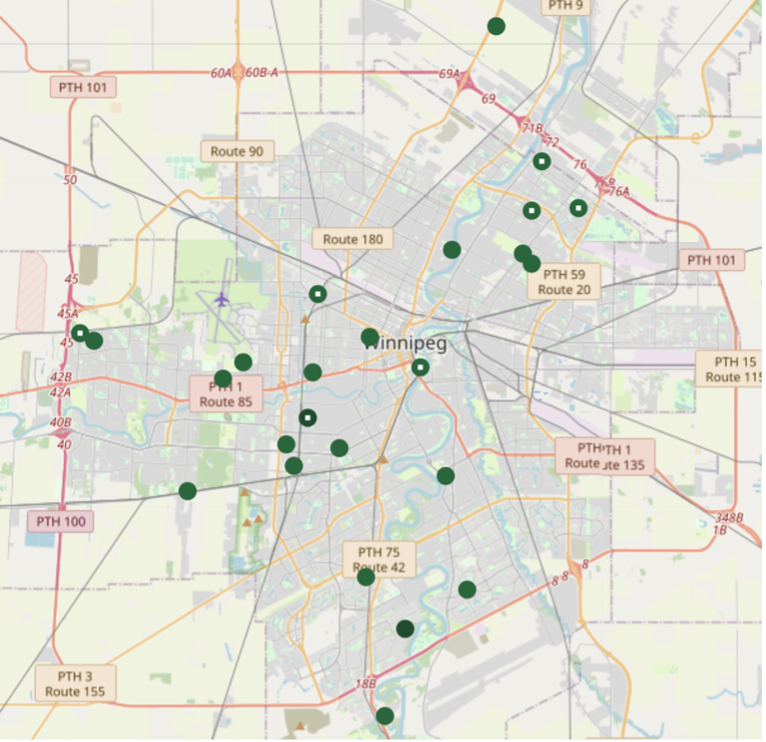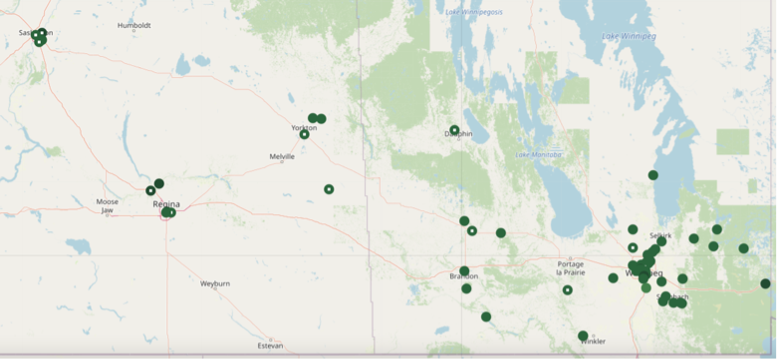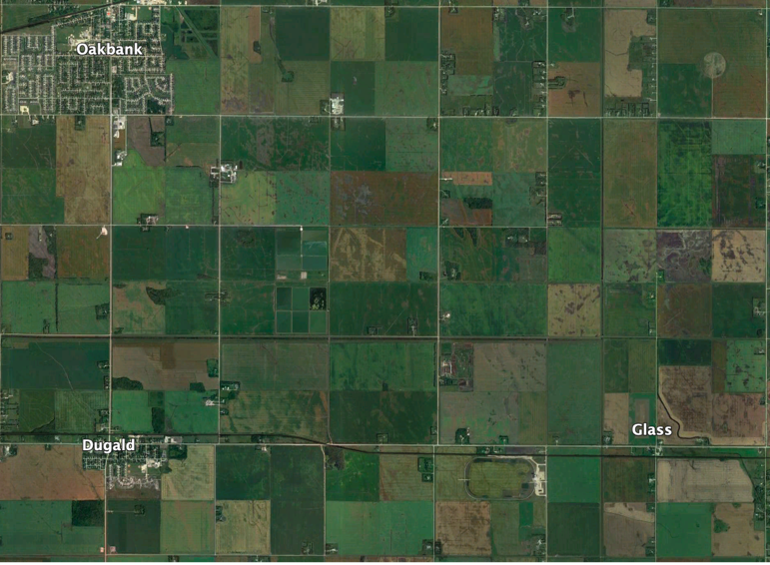Monarchs: Reaching 50N and beyond
Sunday, July 9th, 2023 at 9:29 pm by Chip TaylorFiled under Monarch Migration | Comments Off on Monarchs: Reaching 50N and beyond
by Chip Taylor, Director, Monarch Watch
This text is all about the journey north by monarchs to reach 50N and beyond in Canada. And it’s based on first sightings data posted to Journey North. In this short piece, I will discuss factors associated with the number of monarch first sightings reported in Manitoba and Saskatchewan from 2014-2023. In theory, the numbers arriving in these provinces are a function of the temperature, timing and the size of the first-generation population of butterflies moving north in May and early June.
First generation monarchs originating from the South Region in the United States are on the move to the north from the end of April until about the 12th of June, the approximate date at which directional flight ceases at 50N (Taylor, 2022). Thus, arrival at 50N needs to occur before this date. Since monarchs, even under the most favorable conditions, are unlikely to reach 50N before the 15th of May, and most often later, the window of opportunity to reach the prairie provinces is close to three weeks*. Because the window is narrow, the weather during this interval is critical and the temperatures and wind conditions have to favor directional (migratory) flight. Interestingly, the window can narrow if cold weather in late May and early June inhibits directional flight and the arrival of monarchs, but it can’t be lengthened beyond 12 June. Narrowing the window of arrival is something that occurs at all northern latitudes from time to time – with earlier end dates at lower latitudes (Taylor, 2022).
Support for this interpretation comes from an answer to a simple question. Why did Fred Urquhart say in his book “The Monarch Butterfly”: “In the summer of 1958 the numbers had been so reduced in some areas that the Monarch was considered rare.” The answer involves low temperatures throughout most of the growing season. The mean March and April temperatures in Texas and the April temperature Oklahoma were too low for normal colonization and population development (49.3F, 62.6F and 56.8F respectively). These conditions delayed the development of the population for weeks, and probably resulted in a small first generation that moved north in May and early June. The first generation advanced into areas where May and early June temperatures were below long-term averages. For example, the mean temperatures for May and June in Buffalo, NY were 53.9F (-4.7F) and 61.9F (-5.7F). These temperatures may have prevented recolonization in some areas and delayed it in others. The temperatures that followed the rest of the breeding season were also below average (-2.4F in the Upper Midwest). This sequence of conditions, none of which favored normal population growth, surely resulted in a low fall population that was deserving of Fred Urquhart’s assessment. The sequence of weather events in 1958 appear to be a case in which a delayed start to the population led to an outcome that carried over into the following year.
Because directional flight seems to decline when temperatures are less than 66F, I use that temperature to list the number of days less than 66F as a measure of the days with unfavorable conditions. This is a surrogate measure, an approximation, but it seems to be associated with negative and positive outcomes.
Our only proxy for the number of first-generation monarchs moving north from late April to mid-June is the number of first sightings recorded by Journey North. We have summarized these numbers by longitude and latitude into 10-day intervals from 1May-9June. This tabulation is also a proxy for the number of butterflies moving north during this period. These numbers also reflect the conditions that enable migratory flight and the opportunities for monarchs to be observed.
Table 1. First sightings from 1May to 21June reported to Journey North for Manitoba and Saskatchewan from 2014-2023 in relation to mean temperatures for May and June in Winnipeg, days <66F, and first sightings from 90-100W longitude north of 35N. The later represents the first sightings from 1May to 9June. Green=good, yellow=neutral and pink=bad conditions.
There are several patterns in the data summarized in Table 1. First, the temperatures in Winnipeg appear to be getting warmer from 2014 to 2023, especially in June. Second, along with these increases, the numbers of first sightings in Manitoba and Saskatchewan have been increasing, particularly in years with higher May and June temperatures. Third, there appears to be an association between the number of first sightings in 90-100W (north of 35N) and the total sightings in the provinces. All years with less than 169 sightings had low numbers in the provinces. The number of days with temperatures greater than 66F may also be a factor.
However, there are inconsistencies in these patterns which is to say that the expectations set by some conditions were not met in some years. For example, based on the outcomes from 2019-2023, the number of monarchs sighted in the provinces in 2018 should have rivaled those of 2021 and 2023, particularly since the temperatures for both 2018 and 2023 were nearly identical. This result tells me that it’s likely that something occurred during or after 2018 that the metrics didn’t account for – such as a sharp increase in reporting that occurred after 2018. Statistics have not been applied here since there is no way to account for the increase in the number of citizens interested in monarchs since 2014.
While there appears to be an association between temperatures and the number of monarchs in the first generation that influences the colonization of the prairie provinces, more data is needed. Earlier records are not helpful. Although the Journey North first sightings record began in 2000, the numbers were not robust enough for this type of analysis until 2006. Further, the temperature records for Winnipeg only date back to 2014. So, to be sure of these relationships, we will have to track these numbers into the future.
Still, this is an interesting dynamic, and going forward, as the temperatures increase, it is reasonable to expect that the numbers of monarchs arriving in the provinces in late May and June will increase. Actually, that applies to most of Canada. Whether that will lead to good or bad outcomes is an open question. Much will depend on the abundance of milkweeds**, if increasing temperatures delay the departure or progress of migrating monarchs and whether the increasing distance itself takes a toll on the migrants.
*The window for first generation monarchs to reach the western provinces in Canada appears to be just over three weeks. Of the 24 first-of-the-year sightings for Manitoba, 21 (87%) occurred between 20 May and 13 June (25days). Fifty percent of these first sightings occurred from 26May to 4June. The earliest first sighting occurred on the 12th of May 2012. The arrival window is as long as five or six weeks at the most southerly latitudes.
**The prairie provinces are intensely farmed as seen in the screen shot of an area east of Winnipeg below. The distribution and abundance of milkweeds in these landscapes will set the upper limit for the size of the fall population.
Reference
Chip Taylor, 2022, Monarch Puzzle Wrap Up, Monarch Watch Blog.
First sightings in the greater Winnipeg area in 2023.






Sorry, comments for this entry are closed at this time.